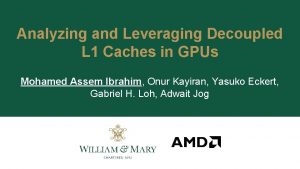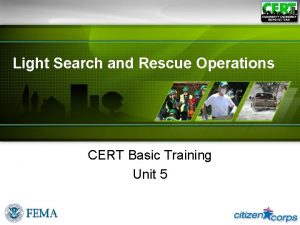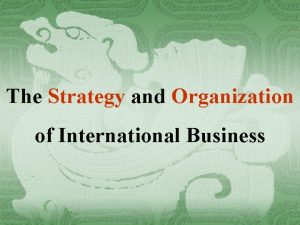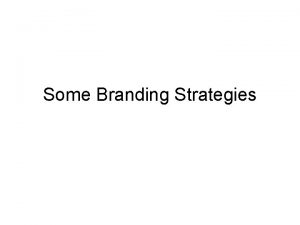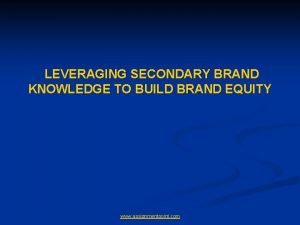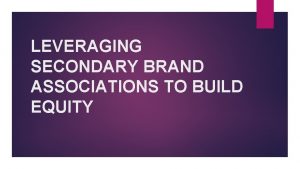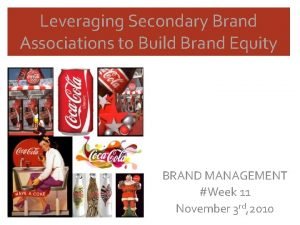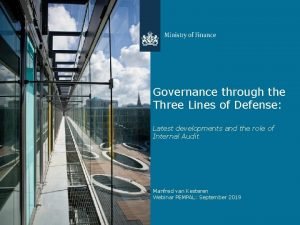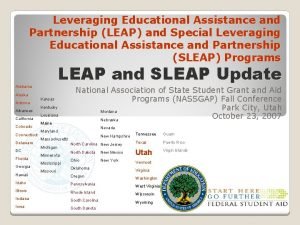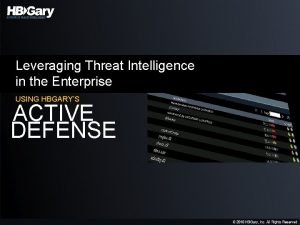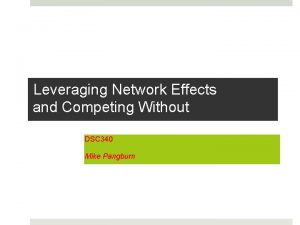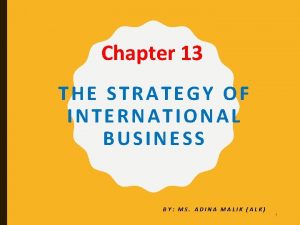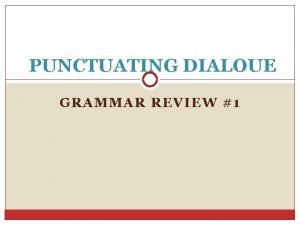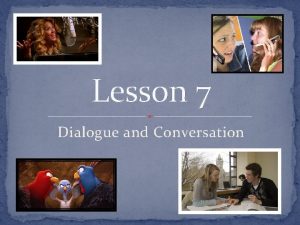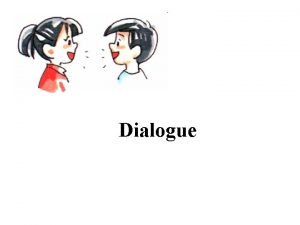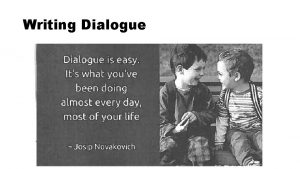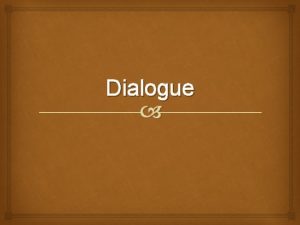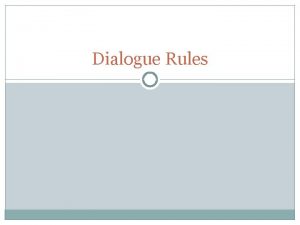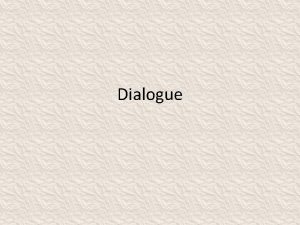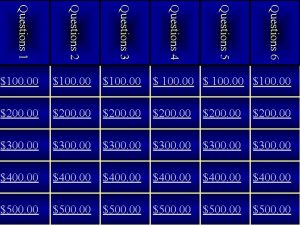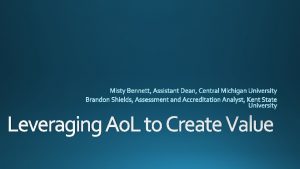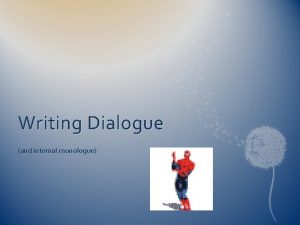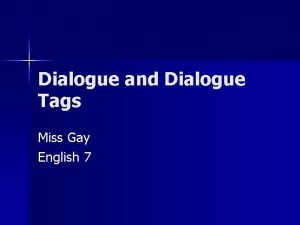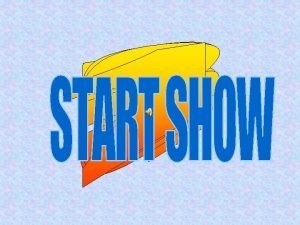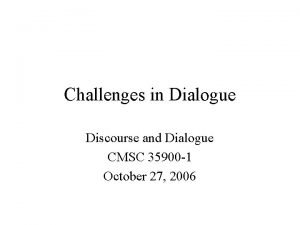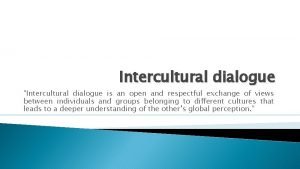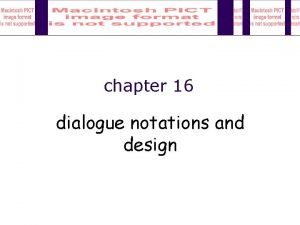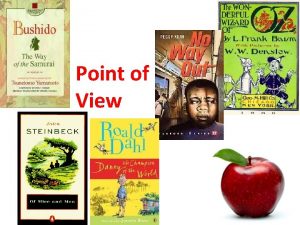Leveraging the Power of Questions for Dialogue and




































































































- Slides: 100

Leveraging the Power of Questions for Dialogue and Discussion Sarah Westbrook The Right Question Institute Cambridge, MA Access today’s materials at https: //rightquestion. org/events/ rightquestion. org

Who is in the room?

Ode to Teachers by Pat Mora I remember the first day, how I looked down, hoping you wouldn’t see me, and when I glanced up, I saw your smile shining like a soft light from deep inside you. I read and reread your notes praising my writing, and you whispered, “We need you and your stories and questions that like a fresh path will take us to new vistas. ” “I’m listening, ” you encourage us. “Come on! Join our conversation, let us hear your neon certainties, thorny doubts, tangled angers, ” but for weeks I hid inside. Slowly, your faith grew into my courage and for you— instead of handing you note or apple or flowers— I raised my hand.

Today’s Agenda 1) 2) 3) 4) 5) 6) 7) 5) 6) Welcome & Community Building Why Spend Time on Teaching Question Formulation? Collaborative Learning with the Question Formulation Technique Wellness Break Classroom Applications with Sasha Moore and Josh Adler Table Discussions & Designing a QFocus Lunch Breakout Groups Sharing Action Plans and Final Reflections

To Access Today’s Materials: https: //rightquestion. org/events/ Join our Online Community for: § Templates you can use tomorrow in class § Classroom Examples § Instructional Videos § Forums and Discussions with other Educators

Use and Share These Resources The Right Question Institute offers materials through a Creative Commons License. You are welcome to use, adapt, and share our materials for noncommercial use, as long as you include the following reference: “Source: The Right Question Institute (RQI). The Question Formulation Technique (QFT) was created by RQI. Visit rightquestion. org for more information and free resources. ”

We’re Tweeting… @Right. Question @Sarah. RQI #QFT

+ Why spend time teaching the skill of question formulation?

Honoring the Original Source: Parents in Lawrence, Massachusetts, 1990 “We don’t go to the school because we don’t even know what to ask. ”

"There is no learning without having to pose a question. " - Richard Feynman Nobel Laureate, Physics, 1965

“We must teach students how to think in questions, how to manage ignorance. ” – Stuart Firestein Former chair, Department of Biology, Columbia University

Importance of Questions in the Workplace “It has always bothered me how even ordinary conversations tend to be defined by what we tell rather than by what we ask. Questions are taken for granted rather than given a starring role “What we choose to ask, when we ask, what our underlying in the human drama. Yet all my teaching and consulting experience has taught me that what builds a relationship, what attitude is as we ask—all are key to relationship building, to solves problems, what moves things forward is asking the right communication, and to task performance. ” questions. ” - Edgar Schein Professor Emeritus at the MIT Sloan School of Management Humble Inquiry (2013)

College Presidents on What College Students Should Learn “The primary skills should be analytical skills of interpretation and inquiry. In other words, know how to frame a question. ” - Leon Botstein, President of Bard College “…the best we can do for students is have them ask the right questions. ” - Nancy Cantor, Former Chancellor of University of Illinois The New York Times, August 4, 2002

Yet, Only 27% of Graduates Believe College Taught Them How to Ask Their Own Questions Alison Head, Project Information Literacy at University of Washington, 2016

But, the problem begins long before college…

Question Asking Declines with Age Tizard, B. , Hughes, M. , Carmichael, H. , & Pinkerton, G. (1983). Dillon, J. T. (1988).

Who is Asking Questions? Tizard, B. , Hughes, M. , Carmichael, H. , & Pinkerton, G. (1983).

What happens when our students grow up and become…us?

The Uneven Communication Problem Leigh Thompson, Creative Conspiracy: The New Rules of Breakthrough Collaboration (2013)

The Uneven Communication Problem Leigh Thompson, Creative Conspiracy: The New Rules of Breakthrough Collaboration (2013)

We can work together on changing these dynamics

We Are Not Alone More than 1 million classrooms worldwide

What happens when students do learn to ask their own questions?

Research Confirms the Importance of Questioning Self-questioning (metacognitive strategy): • Student formulation of their own questions is one of the most effective metacognitive strategies • Engaging in pre-lesson self-questioning improved students rate of learning by nearly 50% (Hattie, p. 193) John Hattie Visible Learning: A Synthesis of Over 800 meta-Analyses Relating to Achievement, 2008

Student Reflection “The way it made me feel was smart because I was asking good questions and giving good answers. ” -Boston 9 th grade summer school student

+ Collaborative Learning with the Question Formulation Technique (QFT)

The Question Formulation Technique (QFT) Individuals learn to: § Produce their own questions § Improve their questions § Strategize on how to use their questions § Reflect on what they have learned and how they learned it

Rules for Producing Questions 1. Ask as many questions as you can 2. Do not stop to answer, judge, or discuss 3. Write down every question exactly as stated 4. Change any statements into questions

Produce Questions 1. Ask Questions 2. Follow the Rules • Ask as many questions as you can. • Do not stop to answer, judge, or discuss. • Write down every question exactly as it was stated. • Change any statements into questions. 3. Number the Questions

Question Focus Some individuals in our community are not asking questions. Please write this statement at the top of your paper. Remember: Number the questions. Follow the rules.

Categorize Questions: Closed/Open Definitions: • Closed-ended questions can be answered with a “yes” or “no” or with a one-word answer. • Open-ended questions require more explanation. Directions: Identify your questions as closed-ended or open-ended by marking them with a “C” or an “O. ”

Discuss Closed-ended Questions Advantages Disadvantages

Discuss Open-ended Questions Advantages Disadvantages

Improve Questions • Take one closed-ended question and change it into an openended question. Closed Open • Take one open-ended question and change it into a closedended question. Open Closed

Prioritize Questions Review your list of questions • Choose three questions you consider most important. • While prioritizing, think about your Question Focus: Some individuals in our community are not asking questions. After prioritizing consider… • Why did you choose three questions? • Where are your priority questions in the sequence of your entire list of questions?

Action Plan From priority questions to action plan… In order to answer your priority questions: • What do you need to know? Information • What do you need to do? Tasks

Action Plan In order to answer your priority questions: • What do you need to know? Information • What do you need to do? Tasks Information Tasks

Share 1. Questions you changed from open/closed 2. Your three priority questions and their numbers in your original sequence 3. Rationale for choosing priority questions 4. Your action plan

Reflect • What did you learn? • How did you learn it? • What do you understand differently now about some individuals in our community are not asking questions?

Today’s Agenda 1) 2) 3) 4) 4) 5) 6) Welcome & Community Building Why Spend Time on Teaching Question Formulation? Collaborative Learning with the Question Formulation Technique Wellness Break Classroom Applications with Sasha Moore and Josh Adler Table Discussions & Designing a QFocus Lunch Breakout Groups Sharing Action Plans and Final Reflections

A Look Inside the Process

The QFT, on one slide… 1) Question Focus 2) Produce Your Questions ü Follow the rules ü Number your questions 1. Ask as many questions as you can 2. Do not stop to discuss, judge or answer 3. Record exactly as stated 4. Change statements into questions 3) Improve Your Questions ü Categorize questions as Closed or Open-ended ü Change questions from one type to another 4) Strategize ü Prioritize your questions ü Action plan or discuss next steps ü Share 5) Reflect Closed-Ended: Answered with “yes, ” “no” or one word Open-Ended: Require longer explanation

Three thinking abilities with one process

Thinking in many different directions Divergent Thinking

Narrowing Down, Focusing Convergent Thinking

Thinking about Thinking Metacognition

Benefits of a Protocollon Kolla = “glue” Diplomacy Science “A plan for inquiry” “Protocols provide a way for people with different interests, even deeply antagonistic interests, to interact productively and respectfully. ” Easton, L. B. (2009). Protocols for Professional Learning. Mc. Donald, J. P. (1996). Redesigning school: Lessons from the 21 st century.

+ Exploring Real-Life Examples

Classroom Example: 3 rd Grade Teacher: Sasha Moore, Santa Monica, CA Topic: Solar Systems Purpose: § To assess what students already know about “Our Solar System” § To offer students an opportunity to have an authentic and active voice for determining their next steps as astronomers

Question Focus Our Solar System

Student Questions 1. How is an asteroid built? 2. Where does a black hole go to? 3. Is there anymore life in our solar system? 4. How fast does the moon spin? 5. How long does it take for the earth to spin? 6. How hot is the sun? 7. Why does Saturn have its rings? 8. How were stars made? 9. Why does Jupiter have a red spot? 10. Why does Jupiter have so much gravity? 11. What was the first planet? 12. Where does the solar system end? 13. How many stars are there? 14. How many galaxies are there? 15. How was the sun created?

Student Questions 1. Is there life on any other planet? 2. What is it like behind a black hole? 3. Who is the actor for Apollo 13? 4. Are they ever going to make a hotel on Mars? 5. Is there any other planet in the solar system with life on it? 6. Is anyone going to make anything so someone can life on space without a space suit? 7. Are you able to go inside a planet? 8. How hot is the sun? 9. Will people one day be able to breathe in space without any equipment? 10. How many moons are there on Jupiter and Saturn? 11. Will anyone ever be able to travel to the center of the earth? 12. If we trash up all of our planets, where will we be able to live?

Categorization & Prioritization § The instructions were: “Pick 3 questions you want to explore further” § At first, students had trouble reaching consensus. They tried it a second time, with some adaptations: Students used pre-made post-it notes with “C” and “O” to make categorizing open and closed easier Students used 3 pink arrows on the left side of the paper to give their final group decision for the 3 priority questions. During prioritization, students first had the chance to select their individual favorite with an arrow on the right hand side. Then, the group could visually see where the consensus was.

Next Steps § The QFT process itself was carried out by one of two 3 rd grade classes (3 WEST) § After the priority questions were gathered from all four groups of 3 WEST (12 questions total), they were put up on the wall, and the other 3 rd grade class looked at them (3 EAST) § Students from 3 EAST looked for patterns in the questions and marked similar questions with a dot. The categories of “planets” and “black holes” emerged § Students will explore these two topics next in the unit

Student Reflections How did it feel to use the QFT? “It felt good to know that you care about us and what we want to learn. ” What did you learn about using the QFT? “Sometimes it is helpful to not answer questions right away. Because we didn’t and we don’t know answers to all of the questions, we got to help decide how we can explore them in science. ” How do you feel about asking questions? “I like asking questions. I like to talk a lot. I wonder about stuff so asking questions helps me be curious. ”

Classroom Example: 8 th Grade Humanities Teacher: Josh Adler, Santa Monica, CA Topic: Thi Bui's The Best We Could Do & the Vietnam War Purpose: To introduce a graphic memoir and explore its connection to themes of migration and asylum

Question Focus

Student Questions

Next Steps § Students shared priority questions using an online tool called Mentimeter, and reviewed the questions in class. § The questions were uploaded in PDF form onto the class website so that students could refer to them as they engaged with reading the book.

Classroom Example: 8 th Grade Humanities Teacher: Josh Adler, Santa Monica, CA Topic: UN Sustainable Development Goals Purpose: To launch a PBL; Creating awareness-raising projects for the XRDS community

Question Focus § Each group was assigned one of the UN’s 17 Sustainable Development Goals (SDGs) SDG #14: Life Below Water: Conserve and sustainably use the oceans, seas and marine resources for sustainable development.

Priority Questions: Zero Hunger 1. How can life on water affect life on land? 2. What can people do to help and what is the government doing to help? 3. What is causing damage to the ocean?

Next Steps § Once the students went through the QFT, they used their three priority questions to help guide the next few weeks of project based learning. § Ultimately, students crafted awareness-raising projects on their SDG, and they presented their work at info tables on campus for the whole school community.

Final Product: Life Below Water Project

Applications in Adult Learning Settings

Professional Learning Example Facilitator: Kendall Evans, Director of Diversity and Inclusion Setting: Start of the year conversation with faculty at an independent school in Austin, TX Purpose: To open up dialogue among teachers about equity and inclusion needs and goals at the school

Question Focus Diversity, Equity, and Inclusion at St. Andrew’s

Questions Produced 1. What education and actions do we need to be an inclusive community? 2. What spaces on our campus create further separation for students? How can we change spaces where students of color may feel marginalized? 3. How do we repair relationships when we mess up? 4. How do I know how much my students of color want to take on in any space? (advisory, class, etc. ) 5. Where are our opportunities to build trust and community with students and parents? 7. How can we be more on point when speaking with white friends, co-workers, etc. about these important topics? 8. How do we define what needs to be addressed on this campus? 9. Where are we as a school on what teachers can say about race? (i. e. naming white privilege) 10. How do we reach the highest level of development in regards to race conversations? How do we remove shame from these conversations? 11. How do we handle these conversations when certain stake holders are not there? 12. How do we invite more people of color into our community? 13. How do we genuinely become a community that supports and celebrates a multicultural group/gathering?

Questions Produced 1. What untouchable questions are we not asking? 2. How does shared culture of some teacher/student relationships create inequality in the classroom? 3. To what extent is the school open to changing to accommodate values/beliefs of ALL families who comprise the school? 4. What to do with white families who see anti-racism as liberal/political? How do we address the fact that we ARE this? 5. How do we educate parents about these issues? 6. *Do people perceive that we have a base we can’t upset ($)? Can we disrupt the historical idea that we are a school for white flight and privilege? 7. Can we change the tendency to stay color mute? 8. How can our community learn to be more forthright but forgiving? 9. Is anyone else uncomfortable to be named white with a capital 'W'? 10. How can we undo the normalization of whiteness? 11. What role do administrators (development/marketing office) have to play in creating an anti-racist school? Calling families “clients”: how does our vocab contribute to privileging certain groups/their expectations? 12. Higher level classes = racial inequality? How can we disrupt? What changes have we made to help address this? What else could we do to affect change? 13. When we have very few kids of a certain identity in the room, how can we create a thoughtful/safe multicultural curriculum? 14. How do the white racial identities of teachers contribute to the system of inequality? 15. Can ignoring race contribute to racism/white supremacy? 16. Should we ask how whiteness plays a role in this story? (i. e. assuming white texts are not about race) 17. How do we disrupt binary thinking to move forward at SAS?

Next Steps § They did another round of the QFT when author, Ali Michael (Raising Race Questions: Whiteness, Inquiry and Education), came to visit later in the year, this time with the entire school community present: students, teachers, parents, alumni, parents of alumni and trustees § They worked in mixed groups to to decide together which questions the school should prioritize in the form of a viable action plan for the rest of the year

Outcomes “It was probably one of the healthier conversations I've been involved in with my upper school faculty and colleagues since I've been here given that it was about diversity and inclusion and involved topics that have in the past led to less than ideal outcomes. I was surprisingly pleased by the outcomes this time around. "

Small Group Discussion At your tables, select one additional snapshot of practice to read. Then, discuss with a partner or trio: 1. Share any questions that you found interesting or surprising 2. Share observations about the meeting/lesson design—how effective was it in meeting the stated objectives? What do you think of the QFocus that was used? 3. How do you see using the QFT in your own work?

Today’s Agenda 1) 2) 3) 4) 4) 5) 6) Welcome & Community Building Why Spend Time on Teaching Question Formulation? Collaborative Learning with the Question Formulation Technique Break Classroom Applications with Sasha Moore and Josh Adler Table Discussions & Designing a QFocus Lunch Breakout Groups Sharing Action Plans and Final Reflections

Putting it into Practice: QFocus Design

Question Focus (QFocus): A stimulus or prompt for questions • A phrase or quotation • An image or video • A podcast or speech • A hands-on experience or experiment • An equation or data set The QFocus is not a question!

Designing a Question Focus An effective QFocus is: 1. 2. 3. Directly tied to lesson’s main idea Simple…but not too simple Interesting or provocative to the people in the room…but not heavy-handed or leading

Professional Learning Example Facilitator: Nat Vaughn, Principal Setting: A whole-school faculty meeting at a middle school in Medfield, MA Purpose: Re-examining homework norms; establishing consistent practices school-wide

Question Focus Homework practices are inconsistent at our school. Homework practices vary at our school.

Outcomes “The conversations that took place resulting from the process were rich, meaningful, and productive. The simple process provided a non-judgmental structure to address a significant ‘issue’ in our school and led us to a position of recognizing and embracing a need for change. ”

Putting it into Practice • Design your own QFocus using the Question Focus (QFocus) design tool. • Then, write your working QFocus on an index card. It’s ok if it is still a bit rough.

QFocus Testing • • Find a partner to work with. Partner 1 volunteers a QFocus for feedback. Give minimal context for the QFocus (topic, objectives). Partner 2 jots down the first few questions that come to mind about the QFocus on the QFocus itself, not the objective or context. Follow the 4 rules! • Partner 1 debriefs with partner 2 and makes revisions based on the questions they received.

WANTED: Q Focus Guinea Pigs Who is willing to share the QFocus you were working on?

Why is the skill of question formulation so important now?

In the Age of Google “How should you respond when you get powerful new tools for finding answers? Think of harder questions. ” – Clive Thompson Journalist and Technology Blogger

Questions and Democracy “We need to be taught to study rather than to believe, to inquire rather than to affirm. ” – Septima Clark Chapter 6 on Septima Clark in Freedom Road: Adult Education of African Americans (Peterson, 1996)

Today’s Agenda 1) 2) 3) 4) 4) 5) 6) Welcome & Community Building Why Spend Time on Teaching Question Formulation? Collaborative Learning with the Question Formulation Technique Break Classroom Applications with Sasha Moore and Josh Adler Table Discussions & Designing a QFocus Lunch Breakout Groups Sharing Action Plans and Final Reflections

Today’s Agenda 1) 2) 3) 4) 4) 5) 6) Welcome & Community Building Why Spend Time on Teaching Question Formulation? Collaborative Learning with the Question Formulation Technique Break Classroom Applications with Sasha Moore and Josh Adler Table Discussions & Designing a QFocus Lunch Breakout Groups Sharing Action Plans and Final Reflections

Today’s Agenda 1) 2) 3) 4) 4) 5) 6) Welcome & Community Building Why Spend Time on Teaching Question Formulation? Collaborative Learning with the Question Formulation Technique Break Classroom Applications with Sasha Moore and Josh Adler Table Discussions & Designing a QFocus Lunch Breakout Groups Sharing Action Plans and Final Reflections

Discuss 1. What did you learn? 2. An “a-ha moment” or a take away from your experience today 3. What questions do you now have?

Closing Reflection & Evaluation Please spend 2 minutes leaving us some feedback. We value your thoughts. http: //bit. ly/38 FCh. Ny

Thank you! Enjoy! rightquestion. org

To Access Today’s Materials: http: //rightquestion. org/events/ Join our Educator Network for: § Templates you can use tomorrow in class § Classroom Examples § Instructional Videos § Forums and Discussions with other Educators

Using & Sharing RQI’s Resources The Right Question Institute offers materials through a Creative Commons License. You are welcome to use, adapt, and share our materials for noncommercial use, as long as you include the following reference: “Source: The Right Question Institute (RQI). The Question Formulation Technique (QFT) was created by RQI. Visit rightquestion. org for more information and free resources. ”

Professional Learning Example Facilitator: Vince Detillio, Supervisor of Professional Learning Setting: Meeting with curriculum-planning team across the district in Olentangy, OH Purpose: To co-create a PD plan around emotion identification

Question Focus Plutchick’s Wheel of Emotions “Being able to recognize emotions is more than simply having labels – students need to learn to apply those labels accurately to themselves and others” All Learning is Social and Emotional: Helping Students Develop Essential Skills for the Classroom and Beyond Source: Plutchick’s Wheel of Emotions https: //www. 6 seconds. org/2017/04/27/plutchiks-model-of-emotions/

Questions Produced 10. Who is Plutchick? (C) → Why should I believe Plutchick? (O) 1. Why is it important to label your emotions? (O)→ Is it 11. Why is serenity and interest the only second tier important to label your emotions? (C) emotion that is combined? 2. Are the most intense emotions in the middle? 12. Are the extremes opposite of one another? 3. Why are the most intense emotions in the middle? 13. What is the significance of the colors? 4. What research has been done to arrive at these 14. How can we apply this in classrooms? emotions? 15. Are you always in one of these at all times? 5. Why are there plus signs but no equals signs? 16. What are the potential dangers of labels (O)→ 6. How are students supposed to recognize the are labels dangerous? (C) difference between sadness and grief? 17. Can rage ever be a productive emotion? (C) → 7. How do you label accurately when you’ve never When might rage be productive? (O) experienced it? 18. What value is there to teaching this at a young 8. Is this an exhaustive list of emotions? age vs. older? 9. What additional emotions should be added? 19. Are these related to the zones of regulation? 20. Do these emotions look different over time and individually?

Professional Learning Example Facilitator: Erin Horne, Preschool/Kindergarten principal Setting: Team meeting with kindergarten teachers in Chicago, IL Purpose: Address concerns, and come to a shared understanding and agreement on students’ play at recess

Question Focus When on the playground, children need big body play

Questions Produced 1. What does consensual play look like? 2. What is the teachers’ role? 3. What does big body play look like? Sound like? Feel like? 4. Can big body play be on the playground structure? 5. How do we teach students to recognize body language and boundaries? 6. Can adults stop big body play? 7. What is the role of trees on the playground? 8. What are procedures for using the bathroom, going to the nurse, forgotten items? 9. What are appropriate games for big body play? 10. What equipment do we need to support this play? 11. What are storage options for the play equipment? 12. What is empowering language students can use during this play? 13. How do we support the need for big body play and communicate with all constituents meaning parents, supervisors, teachers, subs? 14. How can we support big body play when we cannot go outside? 15. What is expected noise level when outside and then when transitioning back into the school? 16. Should there be a transition between the play and next activity? 17. How can we help kids when their play has gone too far? 18. What does restorative justice look like when play has broken down with kids? 19. Does “Stop” “No” and “Ow” suffice for the language we want to teach the kids? 20. Does the child’s awareness of peers change with the age of the children and how does that impact play? 21. Is there an age that the big body play is not necessary?

Outcomes “I've had the experiences of using QFT with faculty and just like with children the process is so worthwhile. My colleagues feel they're part of the discussion and decision. They feel heard. We can come to a shared agreement about decisions that are made because of this process. We will continue the Big Body play discussion, produce a written understanding that we can all follow when supervising and share with the students and parents. ”
 Congratulating and responding to congratulations dialogue
Congratulating and responding to congratulations dialogue Ac power formula
Ac power formula Analyzing and leveraging decoupled l1 caches in gpus
Analyzing and leveraging decoupled l1 caches in gpus Light search and rescue
Light search and rescue There is low interdependence performance ambiguity
There is low interdependence performance ambiguity Brand leveraging strategies
Brand leveraging strategies Leveraging social media for talent acquisition
Leveraging social media for talent acquisition Secondary brand elements
Secondary brand elements Co-branding meaning
Co-branding meaning Leveraging secondary associations
Leveraging secondary associations Coso lines of defense
Coso lines of defense Coso three lines of defense
Coso three lines of defense Louisiana leveraging educational assistance partnership
Louisiana leveraging educational assistance partnership Leveraging threat intelligence
Leveraging threat intelligence Leveraging network effects
Leveraging network effects Leveraging subsidiary skills
Leveraging subsidiary skills Whats a speaker tag
Whats a speaker tag Iso 22301 utbildning
Iso 22301 utbildning Novell typiska drag
Novell typiska drag Tack för att ni lyssnade bild
Tack för att ni lyssnade bild Vad står k.r.å.k.a.n för
Vad står k.r.å.k.a.n för Varför kallas perioden 1918-1939 för mellankrigstiden
Varför kallas perioden 1918-1939 för mellankrigstiden En lathund för arbete med kontinuitetshantering
En lathund för arbete med kontinuitetshantering Personalliggare bygg undantag
Personalliggare bygg undantag Personlig tidbok för yrkesförare
Personlig tidbok för yrkesförare Sura för anatom
Sura för anatom Vad är densitet
Vad är densitet Datorkunskap för nybörjare
Datorkunskap för nybörjare Stig kerman
Stig kerman Debatt artikel mall
Debatt artikel mall Autokratiskt ledarskap
Autokratiskt ledarskap Nyckelkompetenser för livslångt lärande
Nyckelkompetenser för livslångt lärande Påbyggnader för flakfordon
Påbyggnader för flakfordon Vätsketryck formel
Vätsketryck formel Svenskt ramverk för digital samverkan
Svenskt ramverk för digital samverkan Urban torhamn
Urban torhamn Presentera för publik crossboss
Presentera för publik crossboss Vad är ett minoritetsspråk
Vad är ett minoritetsspråk Vem räknas som jude
Vem räknas som jude Klassificeringsstruktur för kommunala verksamheter
Klassificeringsstruktur för kommunala verksamheter Epiteltyper
Epiteltyper Claes martinsson
Claes martinsson Centrum för kunskap och säkerhet
Centrum för kunskap och säkerhet Lågenergihus nyproduktion
Lågenergihus nyproduktion Bra mat för unga idrottare
Bra mat för unga idrottare Verktyg för automatisering av utbetalningar
Verktyg för automatisering av utbetalningar Rutin för avvikelsehantering
Rutin för avvikelsehantering Smärtskolan kunskap för livet
Smärtskolan kunskap för livet Ministerstyre för och nackdelar
Ministerstyre för och nackdelar Tack för att ni har lyssnat
Tack för att ni har lyssnat Vad är referatmarkeringar
Vad är referatmarkeringar Redogör för vad psykologi är
Redogör för vad psykologi är Matematisk modellering eksempel
Matematisk modellering eksempel Atmosfr
Atmosfr Borra hål för knoppar
Borra hål för knoppar Orubbliga rättigheter
Orubbliga rättigheter Stickprovsvarians
Stickprovsvarians Tack för att ni har lyssnat
Tack för att ni har lyssnat Steg för steg rita
Steg för steg rita Vad är verksamhetsanalys
Vad är verksamhetsanalys Tobinskatten för och nackdelar
Tobinskatten för och nackdelar Blomman för dagen drog
Blomman för dagen drog Mästare lärling modell
Mästare lärling modell Egg för emanuel
Egg för emanuel Elektronik för barn
Elektronik för barn Klädsel i rom
Klädsel i rom Strategi för svensk viltförvaltning
Strategi för svensk viltförvaltning Var 1721 för stormaktssverige
Var 1721 för stormaktssverige Humanitr
Humanitr Sju för caesar
Sju för caesar Tack för att ni lyssnade
Tack för att ni lyssnade Vilka tal pekar pilarna på
Vilka tal pekar pilarna på Dikter som rimmar
Dikter som rimmar Inköpsprocessen steg för steg
Inköpsprocessen steg för steg Rbk-mätning
Rbk-mätning Etik och ledarskap etisk kod för chefer
Etik och ledarskap etisk kod för chefer Aktiv expektans
Aktiv expektans Myndigheten för delaktighet
Myndigheten för delaktighet Frgar
Frgar Tillitsbaserad ledning
Tillitsbaserad ledning Läkarutlåtande för livränta
Läkarutlåtande för livränta Karttecken brun triangel
Karttecken brun triangel Skapa med geometriska former
Skapa med geometriska former Vishnuismen
Vishnuismen Var finns arvsanlagen
Var finns arvsanlagen Bris för vuxna
Bris för vuxna Jätte råtta
Jätte råtta Hình ảnh bộ gõ cơ thể búng tay
Hình ảnh bộ gõ cơ thể búng tay Lp html
Lp html Bổ thể
Bổ thể Tỉ lệ cơ thể trẻ em
Tỉ lệ cơ thể trẻ em Chó sói
Chó sói Tư thế worm breton là gì
Tư thế worm breton là gì Hát lên người ơi alleluia
Hát lên người ơi alleluia Các môn thể thao bắt đầu bằng tiếng chạy
Các môn thể thao bắt đầu bằng tiếng chạy Thế nào là hệ số cao nhất
Thế nào là hệ số cao nhất Các châu lục và đại dương trên thế giới
Các châu lục và đại dương trên thế giới Công của trọng lực
Công của trọng lực Trời xanh đây là của chúng ta thể thơ
Trời xanh đây là của chúng ta thể thơ Cách giải mật thư tọa độ
Cách giải mật thư tọa độ 101012 bằng
101012 bằng


